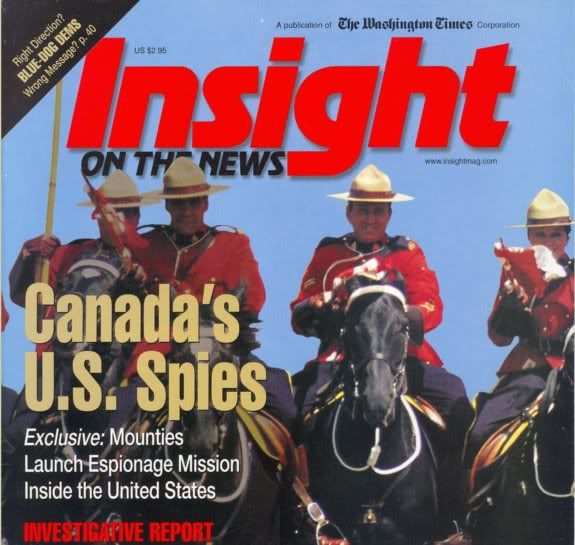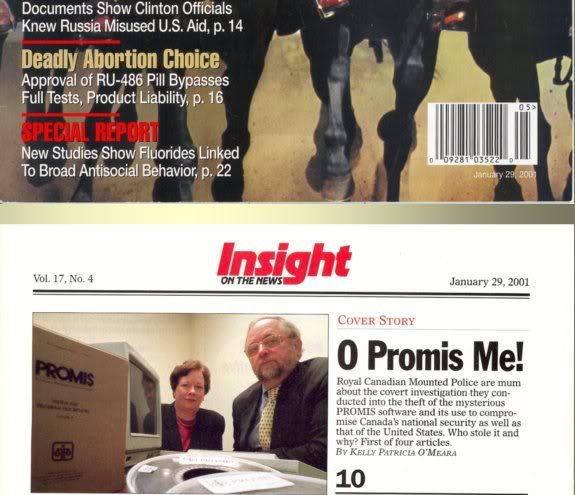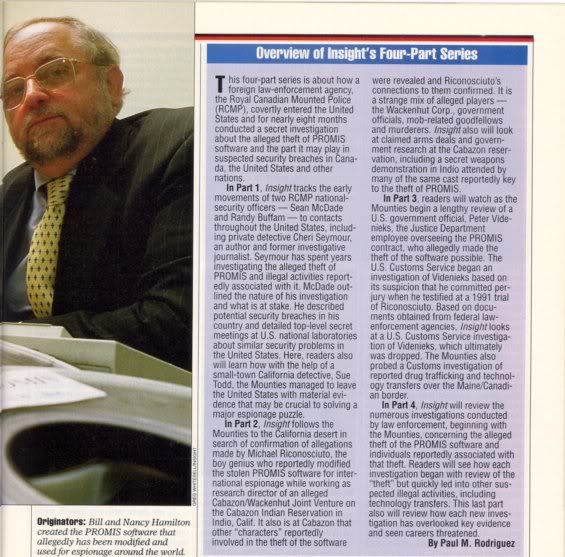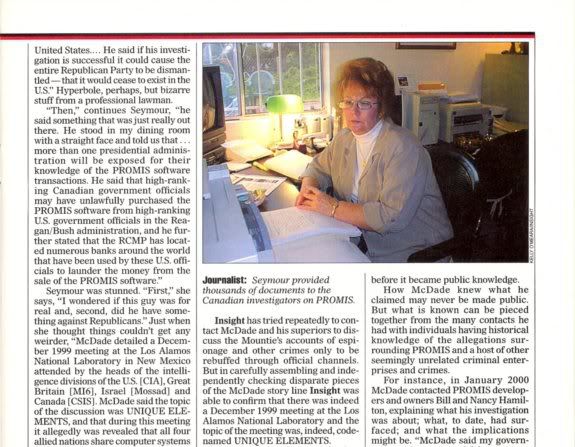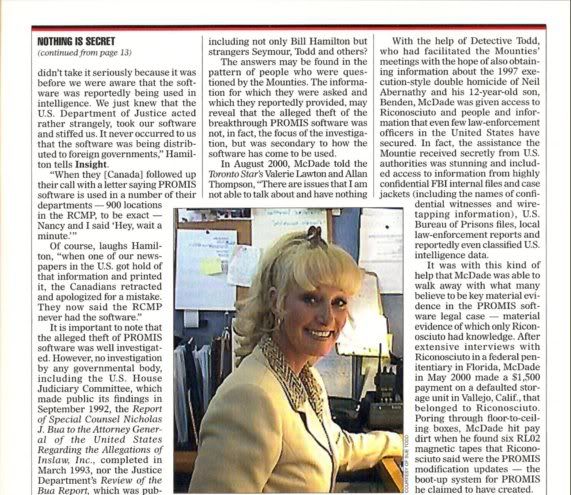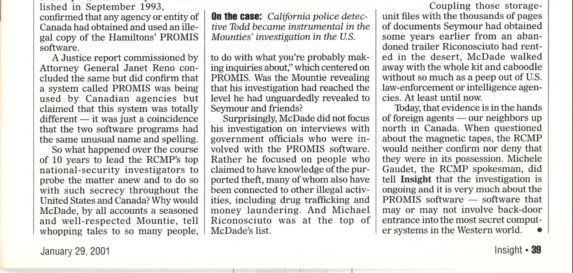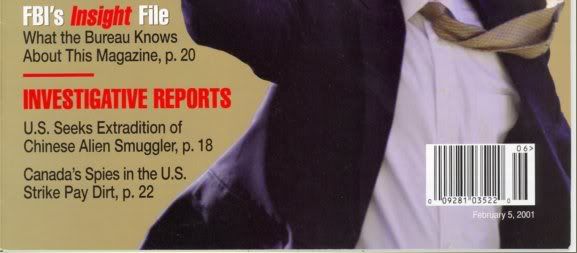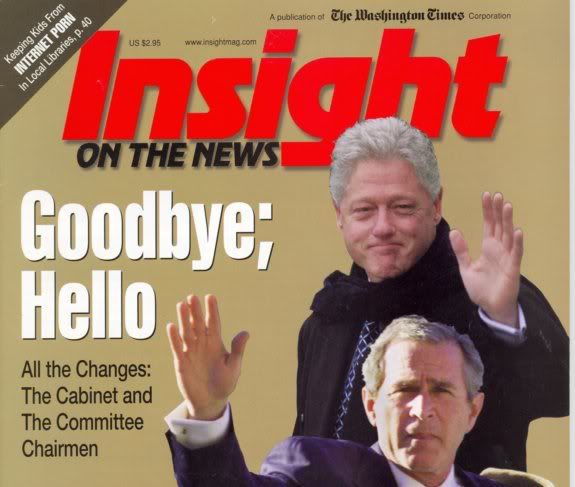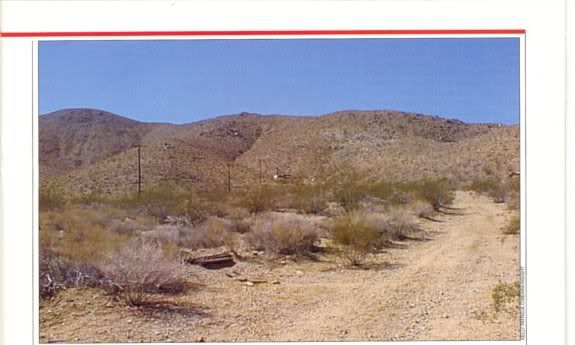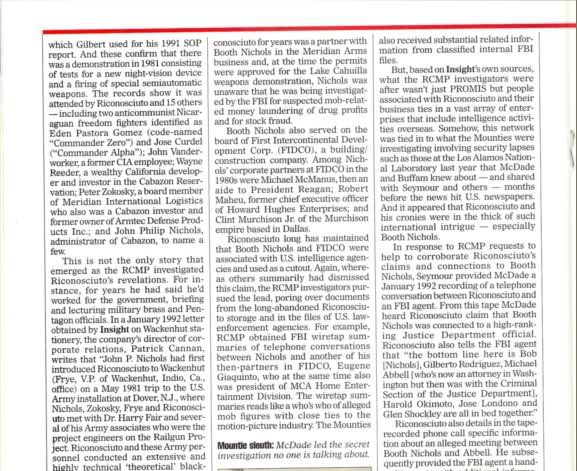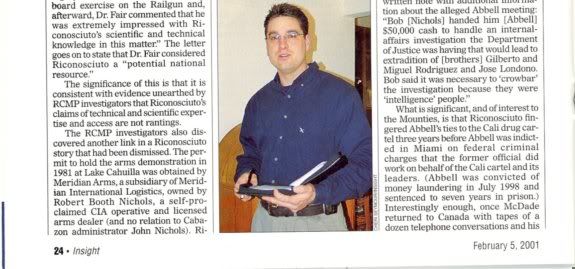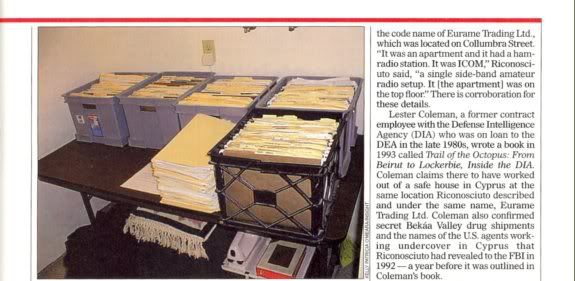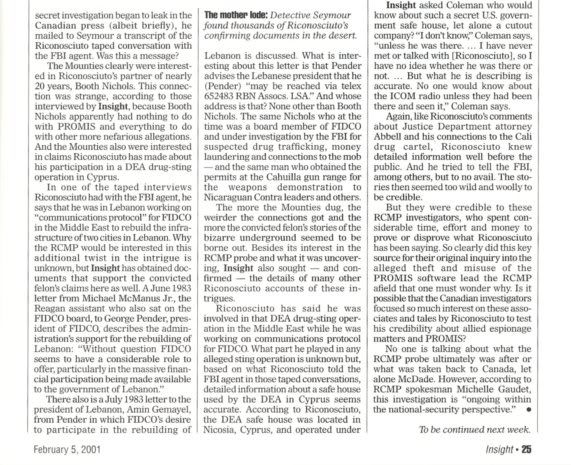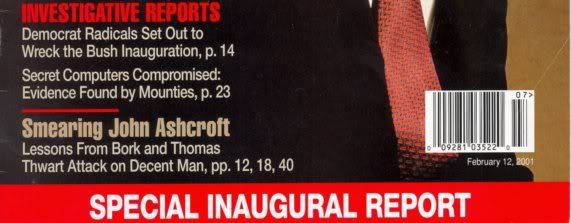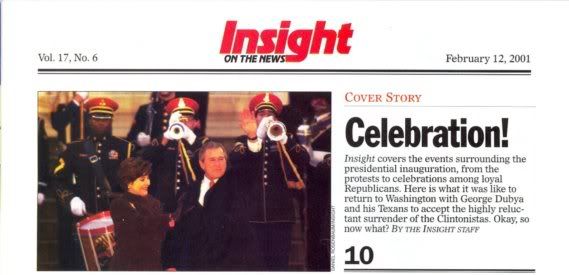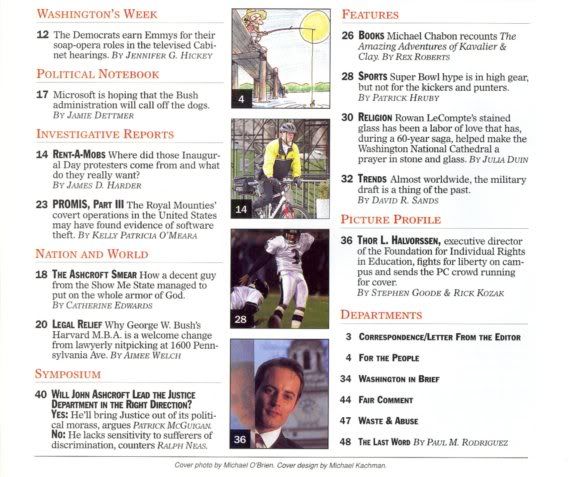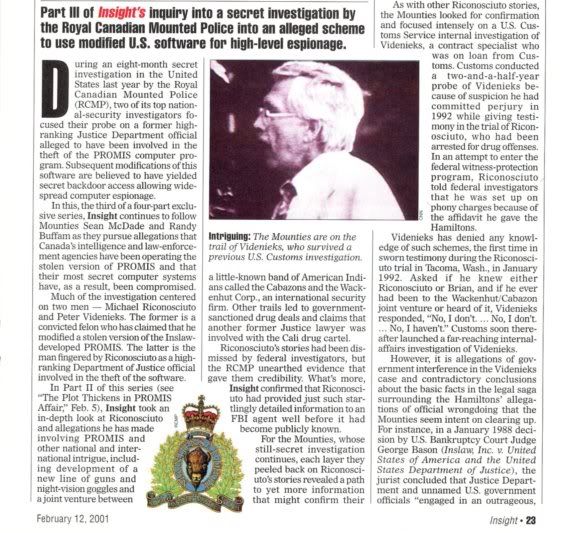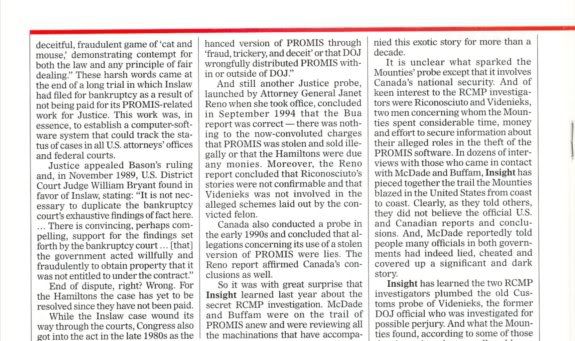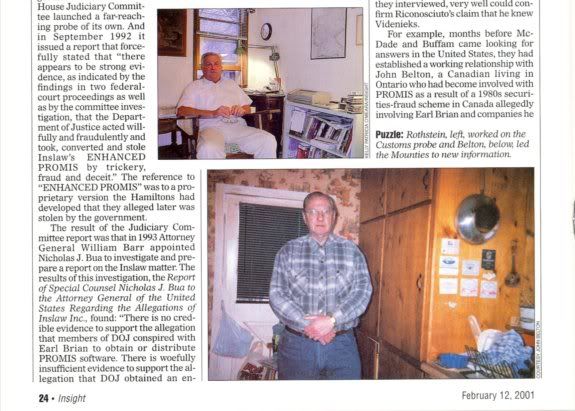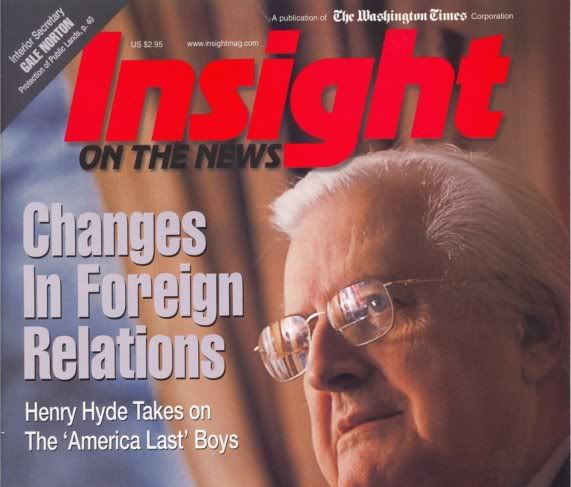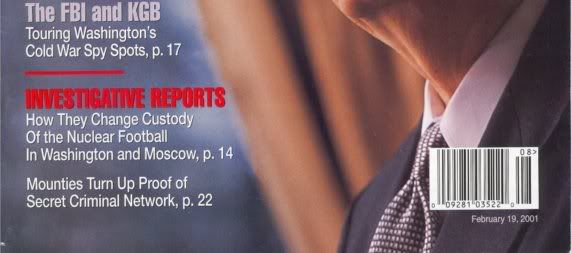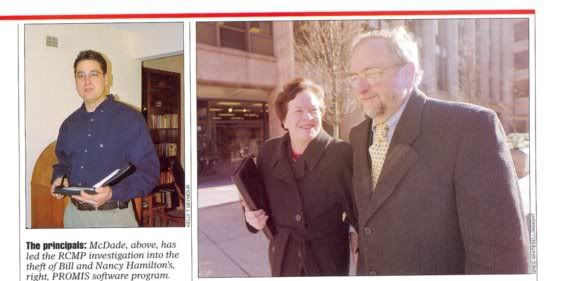seemslikeadream wrote:“Born Classified” Gordon Sivell and Peter Osborne
So who are these guys and where's their book?
I can't find anything on them
Here is a response I just received from Virginia McCullough:
SeemsLikeADream has asked a very intelligent question. By all means feel free to post the following or if you do not want to “channel” please at least forward it on to Jeff Wells.. This gets to the very heart of the matter which is “Who is telling the truth about the Promis software?” Is it William Hamilton and Michael Riconosciuto to the FBI and DOJ? What a hell of a choice. I am talking about the technical issues...Is the old COBAL based software called PROMIS the cadallac of software as the myth goes or is it just a myth? Is the letter below a beautiful cut and paste or was someone stupid enough to put this highly secret arrangement on paper? From: Virginia McCullough [mailto:vmccullough@comcast.net]
Sent: Friday, October 16, 2009 9:16 AM
To: [American Dream]
Cc: Virginia McCullough
Subject: Gordon Sivell and Peter Osborne - The Last Days of Danny Casolaro & The Head of the Octopus.htm
[American Dream]:
Please get this to Jeff Wells so he can take a real close look at Gordon Sivell and his Australian partner Peter Osborne. Gordon was put into my life by Anita Langley because he was allegedly writing the book below. He wrote a chapter on MR without ever visiting him and never sent the chapter to MR for approval. However, Gordon sent the manusacript (as it was at that time) and asked me to edit and/or comment. When I saw the many errors in MRs chapter I sent it to MR thereby incurring the wrath of Sivell.
Please note the following excerpt from below:
The authors recently obtained documentary evidence from William Hamilton, CEO Inslaw Inc, revealing the US Department of Justice and intelligence agencies may have knowingly misled the US Congressional Committee investigating the PROMIS Software scandal, and also misled the governments and citizens of Australia and Canada.
PUBLICLY EXPOSED - LETTER FROM US DEPARTMENT OF JUSTICE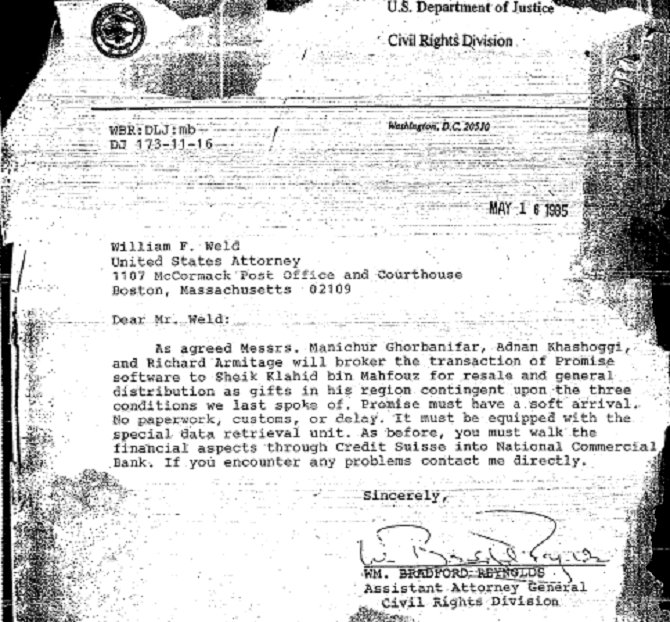
I definitely believe that the preceding is a cut and paste job just like several previously distributed by RuMills et al..................V.
This is Google's cache of http://www.users.on.net/~osbornep/. It is a snapshot of the page as it appeared on Mar 9, 2009 00:48:05 GMT. The current page could have changed in the meantime. Learn more
BCCI, IRAN CONTRA AND PROMIS SOFTWARE DEALS WERE LINKED
Canadian and Australian researchers Gordon Sivell and Peter Osborne will soon publish their book titled “Born Classified”, detailing the secret life of Michael Riconosciuto and the sale of his modified PROMIS Software designed to eavesdrop on the Governments of Canada and Australia.
The files of Michael Riconosciuto were first classified in 1982 by Presidents Ronald Regan and George Bush Senior and were then mysteriously reclassified in 2003 by President George W Bush.
In 1991, Michael Riconsciuto testified in court, that multiple versions of the PROMIS software were provided to him by the US Department of Justice throughout 1981-1983. Rcionsciuto testified that he was contracted to modify the PROMIS Software with advanced eavesdropping capabilities utilizing a special communications receiver unit in order for CIA and NSA to spy on foreign governments. Riconosciuto testified the PROMIS Software was sold to the RCMP/CSIS in Canada and renamed the “LEAN Software” and sold to the Australian Government.
The authors recently obtained documentary evidence from William Hamilton, CEO Inslaw Inc, revealing the US Department of Justice and intelligence agencies may have knowingly misled the US Congressional Committee investigating the PROMIS Software scandal, and also misled the governments and citizens of Australia and Canada. PUBLICLY EXPOSED - LETTER FROM US DEPARTMENT OF JUSTICE
THE TEXT READS
US Department of Justice
Civil Rights Division
Washington DC 20530
WBR: DLJ: mb
DJ 173-11-16
16th May 1985
William F Weld
United States Attorney
1100 McCormack Post Office and Courthouse
Boston, Massachusetts 02109
Dear Mr Weld,
“As agreed, Messrs, Manucher Ghorbanifar, Adnan Khashoggi and Richard Armitage will broker the transaction of the PROMISE Software to Sheik Klahid bin Mahfouz for resale and general gifts in his region contingent upon the three conditions we last spoke of. PROMISE must have a soft arrival. No Paperwork, customs, or delay. It must be equipped with special data retrieval unit. As before, you must walk the financial aspects through Credit Suisse and National Commercial Bank. If you encounter any problems contact me directly.”
Sincerely,
WM, Bradford Reynolds
Assistant Attorney General
Civil Rights Division
In November 2006, William Hamilton, CEO of Inslaw Inc confirmed the existence of the DOJ letter in his article posted on the German Website
http://oraclesyndicate.twoday.net/stories/2945207/ . “Six months before the FBI arrested Jonathan Pollard for espionage, Assistant Attorney General Wm. Bradford Reynolds sent the May 16, 1985 letter to William F. Weld, the U.S. Attorney in Boston, about arrangements made by the Assistant Secretary of Defense for International Security Policy, and two Middle Eastern middlemen who later surfaced in the Iran/Contra scandal, for the sale and distribution of a trap-door version of PROMIS to governments in the Middle East. The Arab broker identified in the letter headed Saudi Arabia’s National Commercial Bank. INSLAW received a copy of the letter in late 2004 from a U.S. intelligence source, and has since obtained convincing indications of its authenticity”.
In the last weeks of the life of investigative journalist Danny Casolaro, prior to his murder, he was convinced the BCCI, Iran Contra Arms, PROMIS Software Scandals were all connected. It appears from this enclosed Letter that Casolaro was CORRECT!
This Letter reveals the US Department of Justice secretly authorised the theft and modification of the PROMIS Software utilizing a special eavesdropping receiver to be sold to foreign governments by the BCCI and Iran Contra conspirators.
Prior to his murder, Danny Casolaro confirmed to friends that he was going to West Virginia to retrieve the Head of the Octopus given he had documentary evidence that confirms:
? A meeting in April 1986 between Adnan Khashoggi and Tiny Roland
? The transfer of Iran Contra Arms involving Adnan Khashoggi
? BCCI Cheques for $1 Million and $4 Million were drawn on Adnan Khashoggi and Manucher Ghobanifar accounts
? IBM (Tel Aviv) connections linking the PROMIS Software with Israeli Intelligence Danny Casalaro was investigating the Iran Contra Arms Deal and he flew to West Virginia to meet with an Arab who was involved in guns-and drugs transfers.
Throughout the US Congressional Committee investigation of the alleged theft of Inslaw’s PROMIS Software by the US Department of Justice, the US Government and intelligence agencies repeatedly denied they had ever modified or sold the PROMIS Software to foreign governments and intelligence agencies.
However, in 1991, Michael Riconosciuto confirmed in a sworn affidavit to Inslaw’s Attorneys and testified at his own court trial that he received multiple copies of Inslaw’s PROMIS Software from Peter Videnieks who was working for the US Department of Justice. Riconosciuto also testified that he was contracted to modify the PROMIS Software to utilize a special hardware communications receiver unit for sale to RCMP/CSIS in Canada and ASIO in Australia to permit the CIA and NSA to eavesdrop on foreign governments. Riconosciuto testified the modified PROMIS Software was renamed LEAN Software for sale to the Australian Government.
The designated recipient of the PROMIS software, Khalid bin Mahfouz, is the eldest son of a Saudi entrepreneur who founded the National Commercial Bank in Saudi Arabia, which is the first bank in his country, which is referred to in the recently discovered letter written by Bradford Reynolds. In 1990, Khaid bin Mahfouz acquired Irish citizenship. In 2006, his personal net worth was estimated at $3.2 billion making him one of the richest people in the world. As a non-executive director of the controversial Bank of Credit and Commerce International (BCCI) bin Mahfouz was indicted by a New York state Grand Jury for fraud but the charges were dropped.
Despite an exhaustive FOI research by INSLAW’s attorney on further correspondence between William Weld and Brad Reynolds they turned up empty. However, in October 2007 William Hamilton acknowledged that a US intelligence source confirmed to him that this letter is the only copy that was not shredded. The authenticity of the letter has been verified by INSLAW. Beginning in July 1986 William Weld succeeded Stephen S. Trott as Assistant U.S. Attorney General in charge of the Criminal Division at the DOJ.
William Hamilton confirms that “Early in 2003, INSLAW Counsel Gray obtained the following explanation for the Bush Administration’s stonewalling of his post-9/11 efforts to settle with INSLAW: Paul Wolfowitz, [Deputy Secretary of Defense], Scooter Libby, [Chief of Staff and National Security Advisor to Vice President Cheney], and Richard Perle, [Chairman of the Defense Policy Board], are opposed to a settlement with INSLAW for fear that any settlement could embarrass Israeli Prime Minister Ariel Sharon and complicate U.S. policy in the Middle East. Each is intimately familiar with the INSLAW case because the government gave PROMIS to Israel”.
In 1992, during the US Congressional Committee investigation of the alleged theft of the PROMIS Software by US Department of Justice (DOJ), INSLAW’s counsel confirmed that four witnesses testified the CIA and DOJ installed the PROMIS Software at the World Bank and International Monetary Foundation (IMF).
? Witness #1, a computer systems specialist who worked at the World Bank Headquarters in Washington, DC for a number of years in the 1980's and who has been reluctant to come forward publicly because of fear of reprisal, claims to have first hand technical knowledge, supplemented by contemporaneous, handwritten notes, of the implementation at the World Bank Headquarters in 1983 of INSLAW's PROMIS computer software product, on a VAX mid-range computer from Digital Equipment Corporation. According to this individual, the World Bank's implementation of PROMIS was not in support of the traditional PROMIS application domain of legal office case management. Instead, the World Bank implemented PROMIS to track its own "international message flow," as well as the international message flow of its sister institution, the International Monetary Fund (IMF).
? Witness #2. a current mid-level U.S. Government employee with extensive experience in intelligence/national security activities, who is fearful of reprisal. claims to have knowledge, obtained contemporaneously with the actual event in June 1983, of a meeting at the World Bank Headquarters in June 1983 concerning DOJ'S conveyance to the World Bank of the "proprietary VAX" version of INSLAW's PROMIS software. According to this individual (who also claims to have contemporaneous handwritten notes), the DOJ was represented at the meeting by D. Lowell Jensen, then Assistant Attorney General for the Criminal Division. Among others who this individual claims attended the meeting was Stanley Sporkin, then General Counsel of the Central Intelligence Agency (CIA). According to this individual, the initiative to implement PROMIS at the World Bank came from the Bank Operations Division of the CIA. This individual, during the course of a recent meeting with attorneys for INSLAW, emphasized repeatedly that anyone who provides information to INSLAW will get into significant trouble, and that there would be swift retribution against anyone in DOJ who even talks about the INSLAW matter. This individual claims that all of the people at DOJ who are responsible for "getting" INSLAW have been promoted and awarded bonuses. Upon information and belief, the objective of the PROMIS implementation at the World Bank was to provide an early warning system to the U.S. intelligence community of signs of planned defaults on international loans. During the first few years of the Reagan Administration, a number of the so-called less developed countries actively considered defaulting on their international debts.
? Witness #3. a current mid-level DOJ career employee who has been in a position to know a good deal about the INSLAW Affair for the relevant period of the 1980's, and who, INSLAW has been told by others, has first-hand knowledge of DOJ's dissemination to the World Bank in 1983 of the PROMIS software, and of the concealment or destruction by DOJ of contemporaneous, written documentation of the conveyance. This individual, during the course of a recent meeting with attorneys for INSLAW, emphasized repeatedly that anyone who provides information to INSLAW will get into significant trouble, and that there would be swift retribution against anyone in DOJ who even talks about the INSLAW matter. This individual claims that all of the people at DOJ who are responsible for "getting" INSLAW have been promoted and awarded bonuses. This individual expresses sorrow and perhaps even shame for what DOJ has done to INSLAW, but declines to acknowledge the validity of any particular claim except through sworn testimony before an independent counsel. This individual states that no one would cooperate with any investigation unless it is truly independent of DOJ, and unless assured of no retaliation. Finally, this individual says that the exodus from DOJ of the Republican Party political appointees will be of some help on the INSLAW matter but that it will not of itself be enough because "too many career people have either been part of destroying INSLAW or have 'winked' at it."
? Witness #4. a former very high ranking DOJ official who told an intermediary in May 1993 that his disclosure of information about DOJ's misconduct against INSLAW would lead to economic reprisals against him by the Republican Party. In early 2005. the authors were warned that Paul Wolfowitz and Richard Perle were extremely upset about their forthcoming book about the PROMIS Software scandal. A few months later, Paul Wolfowitz was appointed as the President of the World Bank to replace Australian born James Wolfensohn.
The authors welcome any further information relating to the Letter from Department of Justice dated May 16, 1985, from any former and current US, Canadian and Australian government, intelligence, law enforcement officials and corporate officials, who also believe the public has a right to know the Truth about the alleged theft and modification of Inslaw’s PROMIS Software Illegally sold by DOJ and CIA to eavesdrop on the governments and citizens of Australia, Canada, Asia and Middle East.
Please Contact:
Peter Osborne at Email Address:
osbornep@internode.on.net Gordon Sivell at Email Address:
gsivell@hotmail.com William Hamilton’s original article that confirms the existence of the DOJ Letter http://oraclesyndicate.twoday.net/stories/2945207/ FBI’s Incapacitating Cover-up
Freitag, 17. November 2006
William A. Hamilton / Washington DC - Resolving the FBI’s persistent and incapacitating information technology problems was one of the main recommendations of the Congressional Joint Inquiry into 9/11 in its December 2002 Final Report. The “persistence” is the result of efforts to conceal the fact that the FBI’s primary information management system is based on software the U.S. Department of Justice stole from a vendor. Justice covertly disseminated the software beyond U.S. Attorneys Offices, the entities authorized to use it, and the government then converted PROMIS to track wire transfers in banks, to track intelligence information in the FBI and U.S. intelligence agencies, and to steal intelligence secrets from foreign governments by selling them a Trojan-horse version.
The FBI’s cover-up of its role in the early 1980s theft of the PROMIS case management software from INSLAW, Inc. prevented the FBI from taking advantage in the mid-1990s of new computing technology that would have enabled dramatic improvements in the software’s ease-of-use. The FBI’s decision to disguise the PROMIS origins of its software, rather than upgrade its ease-of-use, not only fooled experts appointed by a court at the behest of Congress in 1996 but also prevented the FBI from connecting the dots five years later on 9/11 between investigative leads about Arab men coming to the United States for flight training. Connecting those dots might have unraveled the 9/11 plot, according to the FBI. The FBI then wasted the first several years of the war on terrorism on a failed $170 million project to upgrade the ease-of-use on its own.
The cover-up also prompted the FBI to pull its punches when the FBI’s Albuquerque office conducted an investigation into a PROMIS sale in New Mexico during the summer of 1984, the same year the Intelligence Division at FBI Headquarters created the first Bureau-wide case management system using a stolen copy of PROMIS. Employees of New Mexico’s Sandia National Laboratory, one of the two main U.S. intelligence centers on nuclear warfare, complained to FBI Albuquerque that the foreign national who made the PROMIS sale was simultaneously doing business with the Soviet Union. The Intelligence Division supervised all FBI counterintelligence investigations. FBI Albuquerque abruptly terminated its investigation without reversing the illegal PROMIS sale, and advised the Sandia witnesses that they could appeal the decision to FBI Headquarters if they wished.
The example the FBI gave to its own employees in 1984 of the FBI as lawbreaker was not lost on an American spy, an FBI Agent with an unusual interest in software, who worked in the Intelligence Division at FBI Headquarters while it was installing PROMIS. When the FBI’s PROMIS became operational in 1985 under the name FOIMS, FBI Agent Robert Hanssen began the most productive phase of his 20 years of espionage for the Soviet Union and Russia. Hanssen made extensive use of the FBI’s software in his espionage, according to the FBI’s early 2001 complaint against him. The U.S. Government also used Hanssen, a senior FBI counterintelligence agent, to help Germany and England with the installation and use of their stolen copies of PROMIS.
Hanssen also gave the Russians copies of the PROMIS software code used in the FBI and U.S. intelligence agencies to track their intelligence information, and installed by in banks to enable U.S. intelligence to track electronic fund transfers. This software later made its way on the Russian black market to al Qaeda, which used it both to find out what the United States knew about al Qaeda’s plans, by accessing U.S. Government intelligence systems, and to move its funds through the banking system.
INSLAW retained attorney C. Boyden Gray in October 2001 to seek a settlement of its PROMIS copyright-infringement claims by having the government buy a license to the new and fully-tested and debugged point-and-click generation of PROMIS for the war on terrorism. The Bush Justice Department stonewalled Gray, while the FBI worked secretly and in vain to upgrade its version of PROMIS, then and now known as ACS, on its own. Two months after Gray became Ambassador to the European Union in January 2006, Gray’s co-counsel wrote to White House Counsel Harriet Miers to arrange to send her a document on a national security case for which Gray had been lead counsel. He also explained the President’s intervention was essential. Miers telephoned to say that she had spoken to Ambassador Gray in Brussels, and that Gray identified the case as the INSLAW case and added that the government owes INSLAW money. Miers emphasized, however, that INSLAW’s problem is with the government, and she represents the President, and, consequently, INSLAW’s only recourse is to Congress.
There were three significant developments during the summer of 2001 on the connection between the PROMIS software scandal and U.S. vulnerability to al Qaeda.
The first development, the debriefing in 2001 of former FBI Agent Robert Hanssen, revealed that al Qaeda had acquired copies of PROMIS used in the FBI, U.S. intelligence agencies, and banks, and was using the software to stay one step ahead of the United States. On June 14, 2001, The Washington Times published a front-page story entitled Software Likely in Hands of Terrorist, attributed to federal law enforcement staff familiar with Hanssen’s debriefing. The story appeared three months before 9/11, on the day Justice submitted its plea agreement with Hanssen in court under seal. Through that agreement, Justice abandoned its demand for the death penalty in exchange for Hanssen’s confession. The article stated that Hanssen gave copies of PROMIS to his Russian handlers, who later sold copies to bin Laden for $2 million, and that the sophisticated software gives bin Laden access to databases on specific targets of his choosing and the ability to monitor electronic banking sources, easing money-laundering …
The second development, also in June 2001, was the FBI’s award of its Virtual Case File contract to retrofit a point-and-click User Interface to the FBI’s case management software. A point-and-click User Interface is as important to software’s ease of use as an automatic transmission is to an automobile’s ease of use. The technology for building a system with a point-and-click User Interface has been available in the computer industry since 1993, two years before the FBI began the development of the current ACS version of its PROMIS software. However, the FBI not only failed to take advantage of the new point-and-click technology under its $67 million ACS Project in 1995 and 1996, but also failed in its unacknowledged effort to retrofit point-and-click technology to ACS under its four-year, $170 million Virtual Case File project that began in 2001. The use of outdated 1980s case management software in the 21st Century leaves FBI agents at a severe disadvantage in performing their duties, according to Justice’s Inspector General.
The third development during the summer of 2001 was the failure of the FBI to connect the dots between a July 2001 lead from its Phoenix office about Arab men coming to the United States for flight training, and the FBI’s August 2001 arrest of al Qaeda terrorist, Zacarias Moussaoui, at a flight training school in Minneapolis. Both FBI Phoenix and FBI Minneapolis had entered leads into ACS about these items. Because the FBI had never upgraded ACS with a point-and-click User Interface, ACS was difficult to use, and the FBI did not bother to search it to find connections. Minneapolis sent 70 messages in the weeks before 9/11 fruitlessly seeking support from FBI Headquarters for a national security warrant to search Moussaoui’s laptop computer. Had Minneapolis checked ACS, it would have discovered the Phoenix lead, and it could have used it to bolster its request to FBI Headquarters. Minneapolis obtained the warrant after 9/11. What it found could have enabled it to unravel the 9/11 plot, according to the FBI.
Approximately a month after 9/11, on October 16, 2001, Fox News reported that it had learned from government officials that Osama bin Laden may have purchased PROMIS from Russian sources after Russia got it from Robert Hanssen and that the concern is that bin Laden or al Qaeda could get on-line and use it to monitor the worldwide criminal investigation and hide themselves, to monitor the worldwide financial investigation and hide their money, or monitor operations of governments that use the software. Fox News also reported that Hansen, on behalf of the U.S. Government, had helped allies like Germany and England with the installation and use of their versions of the PROMIS program, and that both Germany and England had stopped using PROMIS in the several months since Hanssen’s mid-2001 confession. When Fox News asked what the U.S. Government was doing to plug the holes in U.S. security caused by the software being in the wrong hands, the government’s spokesperson replied that the United States had stopped using PROMIS, but refused to say when. This was the first time the government admitted, even indirectly, its use of PROMIS for intelligence applications.
In reality, the FBI never stopped using PROMIS. The FBI used its ACS software development project in 1995 and 1996 to disguise the PROMIS origins of FOIMS, the FBI’s primary information management system, by converting (translating) the PROMIS-derivative FOIMS from the COBOL computer programming language in which INSLAW had written it, to the NATURAL language made by Software AG. The FBI also later changed the name from FOIMS to ACS. The following excerpt from a May 1996 email message from Software AG in Reston, Virginia to its parent company in Germany is about the conversion of the PROMIS-derivative FOIMS:
Subject: Press Q[uery] on Promis
Fritz: To answer your questions, I would say:
1.Yes, our Federal Professional Service group is in the process of conversting [sic] Promis from Cobol to ADABAS/NATURAL and has just started doing the final testing. So the software is not in use anywhere now; it’s just now getting up and running in the test phase.
The FBI has such a large volume of contracts and work orders with Software AG that the FBI cannot retrieve a copy of the requested 1995/1996 FBI contract with Software AG for the conversion of FOIMS from COBOL to NATURAL without the contract number, according to its response to INSLAW’s pending Freedom of Information Act request.
The FBI's primary information management system, designed using 1980s technology already obsolete when installed in 1995, limited the Bureau's ability to share its information internally and externally. This April 2004 9/11 Commission report unraveled at least part of what the FBI did under its mid-1990s ACS software project.
A brief explanation is needed to understand the FBI’s use of its $67 million ACS Project for a PROMIS cover-up. INSLAW, the federal courts, and Congress had been trying for several years to determine the validity of sworn statements, acquired in early 1991, about the unauthorized use of PROMIS in the FBI and intelligence agencies. In April 1991, Chief Judge Aubrey Robinson of the federal district court in Washington, D.C. ordered the FBI to give INSLAW a copy of FOIMS for comparison with PROMIS. One day before the 30-day deadline, a federal appellate court, on a jurisdictional technicality, set aside the fully-litigated decisions of the first two courts about the Justice Department’s theft of PROMIS through trickery, fraud, and deceit. The year of PROMIS’ theft, 1983, was the year the FBI at first said it planned to contract with INSLAW to help its Intelligence Division install PROMIS, but then, a few months later, told INSLAW it had changed its mind and decided to create new software from scratch.
The appellate decision effectively eliminated the scheduled FOIMS/PROMIS software comparison. The following year, the House Judiciary Committee reconfirmed Justice’s theft of PROMIS, and also complained that Justice had obstructed its attempt to investigate the alleged dissemination of PROMIS to the FBI and U.S. and foreign intelligence agencies, and its plan to compare FOIMS with PROMIS. The Committee demanded that the Attorney General immediately compensate INSLAW for the harm egregiously inflicted, and it threatened to pass a Congressional Reference resolution if necessary. In May 1995, the Senate passed a Congressional Reference resolution on INSLAW, automatically waiving technical defenses available to the government, such as sovereign immunity, and ordering the U.S. Court of Federal Claims to determine whether the United States owes INSLAW compensation for the government’s use of PROMIS.
In January 1996, the U.S. Court of Federal Claims ordered the FBI to produce copies of FOIMS, from its inception in the mid-1980s, to court-appointed experts for comparison with PROMIS. The FBI stalled delivery of FOIMS for six months, ostensibly to process security clearances. In mid-1996, the FBI suddenly announced that the only version of FOIMS still available was the 1996 version. The FBI delivered to the experts in the second half of 1996 what it claimed was the 1996 version of FOIMS. It was written in NATURAL. The FBI later backdated the NATURAL-language version to October 1995, claiming that it had replaced FOIMS with ACS as of that date. These actions were intended to obscure the nexus in 1996 between the FBI’s introduction of the NATURAL-language version of its software, and the court-ordered comparison between the FBI’s software and PROMIS.
The U.S. Court of Federal Claims has exclusive jurisdiction over software copyright infringement claims against the government. In August 1998, the court’s Chief Judge sent an Advisory Report to the Senate stating that the United States would be liable to INSLAW for copyright infringement damages if the government had made any unauthorized derivatives from PROMIS but that INSLAW had not proved that the government had done so. Although the NATURAL-language version of FOIMS is obviously an unauthorized, copyright-infringing derivative of PROMIS, the experts were unable to find the DNA of INSLAW’s PROMIS through their line-by-line code comparison between PROMIS and the FBI’s newly-created NATURAL-language version. The reason is the conversion had automatically reduced the number of lines of the FBI’s code by approximately 90%, invalidating the line-by-line code comparison.
The court-appointed experts were similarly unable to find the PROMIS DNA in other intelligence community software, including software provided by NSA. CIA Director James Woolsey, however, had informed INSLAW Counsel Elliot Richardson three years earlier that an investigation by the CIA’s General Counsel had confirmed that NSA and the CIA were using the identical PROMIS software to keep track of their intelligence information. Richardson memorialized this in his October 1, 1993 letter to Woolsey.
Because of (1) the catastrophic U.S. intelligence failure on 9/11, (2) the government’s admission to Fox News in October 2001 that it had used PROMIS to track its intelligence information, and (3) the fact that INSLAW had a fully-tested and debugged native, point-and-click generation of PROMIS (New PROMIS) operating nationwide in other large public and private sector enterprises, INSLAW retained C. Boyden Gray, White House Counsel to the first President Bush, as its counsel in October 2001 to seek a settlement of INSLAW’s software copyright claims against the United States.
This effort, the first since INSLAW’s counsel Elliot Richardson’s death in 1999, had two objectives: (1) to offer the government use of the latest, completely revamped but fully-tested, version of INSLAW’s PROMIS software for the war on terrorism, and (2) to realize just compensation for the government’s use of unauthorized derivatives of the 1980’s PROMIS in intelligence applications.
Gray met with FBI Director Robert Mueller in late December 2001 and made INSLAW’s proposal. Mueller responded that the FBI did not have any unmet software needs. When Gray pointed out that the FBI had never paid INSLAW for 1980s PROMIS, Mueller responded that he was confident that there was no longer any of the INSLAW software left at the FBI because of software changes made over the years. Mueller advised Gray that Deputy Attorney General Larry Thompson was directly overseeing the FBI’s software problem and that he should direct any INSLAW proposal to him.
Gray had a letter hand-delivered to Thompson on January 8, 2002 requesting a meeting to discuss INSLAW’s proposal. Gray’s letter summarized the government’s misappropriation of the 1980’s generation of PROMIS for intelligence applications and included copies of The Washington Times and Fox News reports. Gray also disclosed in the letter that a former national security colleague of his from the Reagan White House had recently confirmed to him that NSA used INSLAW’s PROMIS to track financial transactions in the banking system. Finally, Gray enclosed two sworn statements from the British author of an early 1999 authorized history of Israeli intelligence concerning admissions about PROMIS made to the British author by a former long-time senior Israeli intelligence official, Rafi Eitan. Defense Minister Ariel Sharon had appointed Eitan in the early 1980s as director of the Israeli intelligence agency that supports Israel’s nuclear weapons program.
The gist of Eitan’s admissions is as follows. A former member of the California cabinet of Governor Reagan arranged for the Reagan Administration to give PROMIS to Israel so friends of that Administration could make money by having Israel sell PROMIS overseas. The version of PROMIS sold overseas was equipped with a trap door to facilitate the theft of intelligence secrets of governments installing PROMIS. The U.S. Justice Department arranged for Eitan to visit INSLAW in early 1983, disguised as a visiting Israeli prosecutor, for a demonstration and briefing on PROMIS. Eitan hired Robert Maxwell, the British publisher, to sell PROMIS overseas, and Maxwell sold over $500 million worth of PROMIS. The CIA also directly arranged the sale of another $30-40 million of PROMIS overseas. PROMIS was a very successful computer-based intelligence initiative. PROMIS was also used by U.S. intelligence in banks, and to track information within such agencies as FBI, CIA, and DEA. Israel eventually exploited PROMIS databases of the U.S. Government in its espionage against the United States.
Deputy Attorney General Thompson, the chief operating officer of the Bush Justice Department, never answered Gray’s letter. Documents obtained under the Freedom of Information Act reveal that Thompson assigned Gray’s letter to the Assistant Attorney General for the Justice Management Division for appropriate handling, and that the Assistant Attorney General decided as early as February 1, 2002 that no action was required and that no response was necessary.
The Bush Justice Department’s stonewalling of INSLAW may be explained by a PROMIS sale that Robert Maxwell made for Eitan in New Mexico in the early 1980s, a sale that apparently had disastrous ramifications for U.S. nuclear security. In interviews for the authorized history of Israeli intelligence, Eitan identified friendly and adversarial governments that bought the trap-door version of PROMIS from Israel through Maxwell, but did not mention Maxwell’s sale of PROMIS in New Mexico. That sale was the subject of a brief foreign counter-intelligence investigation by FBI Albuquerque in the summer of 1984, according to heavily-redacted copies of documents provided by the FBI in response to a Freedom of Information Act request on Maxwell’s sale of PROMIS in New Mexico.
Two technology transfer employees of the Sandia National Laboratory in New Mexico, one of the two main U.S. intelligence centers on nuclear warfare, made a complaint to FBI Albuquerque on June 1, 1984 after learning from NSA colleagues that Maxwell was selling the Soviet Union information obtained from computerized U.S. Government databases, while simultaneously selling PROMIS in New Mexico. FBI Albuquerque’s investigation in 1984 took place while the FBI’s Intelligence Division was spearheading the installation of PROMIS at the FBI. Albuquerque aborted its investigation in August 1984 after advising the complainants that their NSA colleagues could contact FBI Headquarters if they wished to challenge the decision.
A U.S. intelligence employee began that year (1984) to steal U.S. nuclear warfare secrets for Eitan, his Israeli spymaster. Jonathan Pollard used a computer terminal at U.S. Navy intelligence in Maryland to access U.S. intelligence database systems to steal U.S. nuclear secrets. According to press reports, Israel may have traded some of these secrets for the release of Soviet Jews. The New Yorker, in a January 1999 article, reported that CIA Director William Casey gave a CIA station chief the following assessment of the damage to U.S. national security from Pollard’s espionage: … the Israelis used Pollard to obtain our attack plan against the U.S.S.R. all of it. The coordinates, the firing locations, the sequences. And for guess who? The Soviets. How's that for cheating?
Early in 2003, INSLAW Counsel Gray obtained the following explanation for the Bush Administration’s stonewalling of his post-9/11 efforts to settle with INSLAW: Paul Wolfowitz, [Deputy Secretary of Defense], Scooter Libby, [Chief of Staff and National Security Advisor to Vice President Cheney], and Richard Perle, [Chairman of the Defense Policy Board], are opposed to a settlement with INSLAW for fear that any settlement could embarrass Israeli Prime Minister Ariel Sharon and complicate U.S. policy in the Middle East. Each is intimately familiar with the INSLAW case because the government gave PROMIS to Israel.
Six months before the FBI arrested Pollard for espionage, Assistant Attorney General Wm. Bradford Reynolds sent the following May 16, 1985 letter to William F. Weld, the U.S. Attorney in Boston, about arrangements made by the Assistant Secretary of Defense for International Security Policy, and two Middle Eastern middlemen who later surfaced in the Iran/Contra scandal, for the sale and distribution of a trap-door version of PROMIS to governments in the Middle East. The Arab broker identified in the letter headed Saudi Arabia’s National Commercial Bank. INSLAW received a copy of the letter in late 2004 from a U.S. intelligence source, and has since obtained convincing indications of its authenticity.
As agreed, Messrs. Manichur Ghorbanifar, Adnan Khashoggi, and Richard Armitage will broker the transaction of Promise [sic] software to Sheik Khalid bin Mahfouz for resale and general distribution as gifts in his region contingent upon the three conditions we last spoke of. Promise must have a soft arrival. No paperwork, customs, or delay. It must be equipped with the special data retrieval unit. As before, you must walk the financial aspects through Credit Suisse into National Commercial Bank. If you encounter any problems contact me directly.
William A. Hamilton is a computer software specialist, former NSA expert and the inventor of PROMIS software; President of Inslaw Inc. company in Washington D.C.
Contact: w.hamilton(at)inslawinc.com
List of references:
1.The Washington Times article of June 14, 2001.
2. Fox News transcript of October 16, 2001.
3. May 1996 email message from Software AG in Reston, Virginia to Software Ag in Darmstadt, Germany.
4. Elliot Richardson’s letter to CIA Director James Woolsey on October 1, 1993.
5.C. Boyden Gray’s January 8, 2002 letter to Deputy Attorney General Larry Thompson.
6. Two sworn statements by Gordon Thomas about Rafi Eitan’s admissions to him about PROMIS while he was researching Gideon’s Spies: The Secret History of the Mosssad, published in early 1999.
7. Two documents obtained under Freedom of Information Act about the Bush Justice Department’s stonewalling of INSLAW Counsel C. Boyden Gray.
8. Documents obtained from FBI under a Freedom of Information Act request about Robert Maxwell’s sale of PROMIS in New Mexico.
9. W. Bradford Reynold’s May 16, 1985 letter to William Weld.
Further Reading
Promisgate: World's longest spy scandal still glossed over / Part IPromisgate: World's longest spy scandal still glossed over /Part IIPromisgate: World's longest spy scandal still glossed over /Part III[





